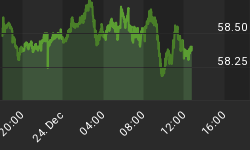Call it the Year of Fear. That's the impression being conveyed with a cursory glance at each day's newspaper headlines. Each new day brings a fresh new fear. Terrorist alerts. Interest rates. The economy and stock market. Russia. Iraq. The list is endless.
Perhaps the biggest fear on Wall Street right now is of course the high price of oil. As indicated in a previous commentary, I believe the crude oil price is undergoing a topping process and this should be the final up-ramp before a major correction.
Check out the following Crude Oil futures chart. It sports a "rising wedge" pattern, which is typically a reversal pattern. In other words, it reflects a peaking oil price trend on the cusp of reversing.

Even more telling is the XOI oil stock index. Notice the recent pattern of lower highs and lower lows. The XOI chart is divergent from the crude oil chart, which again is forecasting a reversal lower for crude oil prices. In technical analysis, divergences are key and this is one divergence not to be ignored.

Remember the "fear collage" from previous weeks? I collect bearish headlines from the leading financial newspapers to measure the level of fear at market bottoms. From a contrarian standpoint, too much fear gives birth to a reversal of trend. Words like "fear," "worry," "concern," etc., are common in headlines at or near bottoms. Well now the fear can be seen in oil-related headlines. Here is a recent sampling of the headlines: "Crude spike unnerves investors," "Russian fears send oil price to record high," "Oil prices hit highs as supply fears grow," "Oil price spikes on supply and demand fears," "Intervention fears outweigh energy revenues," "Report warns on soaring natural gas prices," "US increases its forecast on oil price."
Those last two headlines fall more under the contrarian approach since official forecasts typically prove wrong.
Here's a further sampling of some of the latest financial headlines that, from a contrarian and market psychology standpoint, hint at this coming top: "Traders speculate oil to top $50 by year-end," "Record oil prices dent confidence," "Supply fears push oil prices to new high," "Oil surge heightens worry for corporate earnings," "Oil price specter haunts bourses." I believe the broad market has mostly discounted the oil price shock for now.
What interesting is how the Dow Jones Transportation Index, which is highly oil-dependent, has been trending higher in recent months in the face of the so-called "oil crisis." This suggests that the crisis is overblown and will be over soon. If in fact oil prices were set to continue higher for a prolonged period then it is inconceivable that the Transports would be rising in the face of a sustained oil price uptrend.
From a supply/demand standpoint, the Strategic Petroleum Reserve has been rising in near linear fashion for the past several months. As commentator Don Hays recently pointed out, the inventory in the Strategic Petroleum Reserve is much greater than the entire U.S. inventory. The pundits have been concentrating on the declining trend of the U.S. inventory, but as Hays points out, since the first of the year even that has been moving up.
Conclusion: the oil spike has been grossly overdone, is purely political, and is not a true function of supply/demand. When the oil price trend finally peaks (expected in the very near future), oil will very likely give back much of its 2004 gains.
















